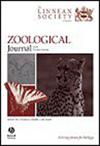Molecular phylogenetic analyses reveal a radiation of freshwater Gammarus (Amphipoda: Gammaridae) in the northern Chihuahuan Desert
IF 3
2区 生物学
Q1 ZOOLOGY
引用次数: 0
Abstract
Isolation of desert springs often leads to the evolution of unique biodiversity. We investigated the taxonomy and evolutionary relationships of members of the Gammarus pecos complex, an assemblage of narrowly endemic amphipod species in the Chihuahuan Desert of the USA. Morphological and molecular phylogenetic analyses, including newly obtained COI sequences from the now-extinct type population of Gammarus desperatus, reveal the presence of two undescribed species and lead to redescription of G. desperatus. Gammarus acerbatus sp. nov. is split from G. desperatus and Gammarus balmorhea sp. nov. is split from G. hyalelloides. Each of these species is endemic to a single spring system. Speciation in the Gammarus pecos complex was likely promoted by the lineage’s ties to marine/riverine systems and geological events during the Oligocene/Miocene. The additional diversity discovered within the complex highlights the effects of both habitat and evolutionary history on the processes of speciation at local and regional spatial scales. The entire complex of at least six species is imperilled due to the narrow ranges occupied by each species and human water-use that threatens the existence of their spring habitats.分子系统发育分析揭示了奇瓦瓦沙漠北部淡水蛤蜊(两栖类:蛤蜊科)的辐射现象
沙漠泉水的隔离往往会导致独特生物多样性的进化。我们研究了美国奇瓦瓦沙漠狭义特有片脚类动物群(Gammarus pecos complex)成员的分类和进化关系。通过形态学和分子系统学分析,包括新近从已经灭绝的绝命虾(Gammarus desperatus)模式种群中获得的 COI 序列,发现了两个未被描述的物种,并对绝命虾(G. desperatus)进行了重新描述。Gammarus acerbatus sp. nov. 从 G. desperatus 中分离出来,Gammarus balmorhea sp. nov. 从 G. hyalelloides 中分离出来。这些物种均为单一泉系的特有种。佩科斯蛤马复合体的物种分化很可能是由于该品系与海洋/河流系统的联系以及渐新世/中新世期间的地质事件所促成的。在该复合体中发现的额外多样性突出表明了栖息地和进化史对局部和区域空间尺度上物种演化过程的影响。整个复合生态系统至少有六个物种濒临灭绝,原因是每个物种占据的范围都很狭窄,而且人类对水的使用威胁到它们泉水栖息地的生存。
本文章由计算机程序翻译,如有差异,请以英文原文为准。
求助全文
约1分钟内获得全文
求助全文
来源期刊
CiteScore
6.50
自引率
10.70%
发文量
116
审稿时长
6-12 weeks
期刊介绍:
The Zoological Journal of the Linnean Society publishes papers on systematic and evolutionary zoology and comparative, functional and other studies where relevant to these areas. Studies of extinct as well as living animals are included. Reviews are also published; these may be invited by the Editorial Board, but uninvited reviews may also be considered. The Zoological Journal also has a wide circulation amongst zoologists and although narrowly specialized papers are not excluded, potential authors should bear that readership in mind.

 求助内容:
求助内容: 应助结果提醒方式:
应助结果提醒方式:


